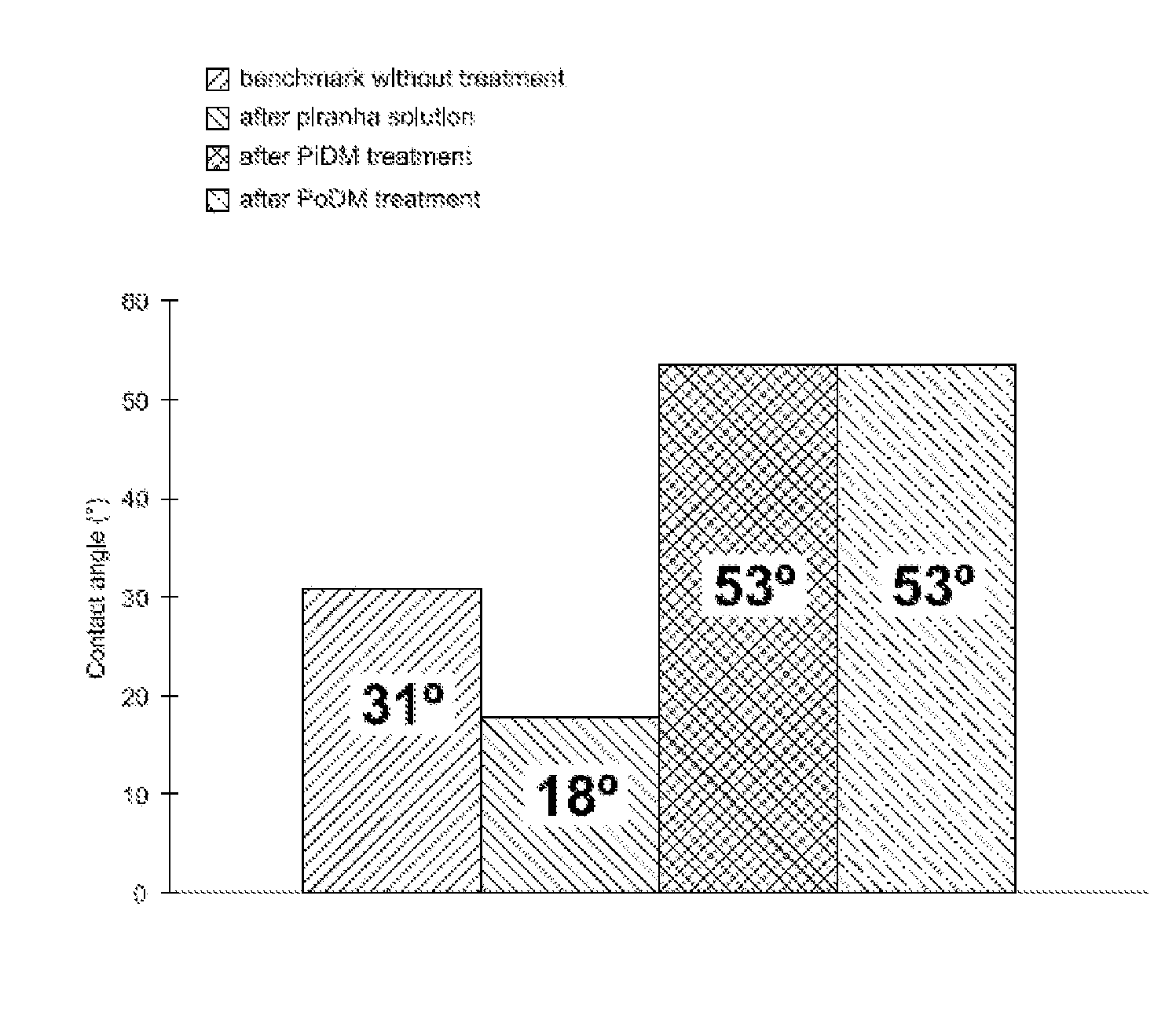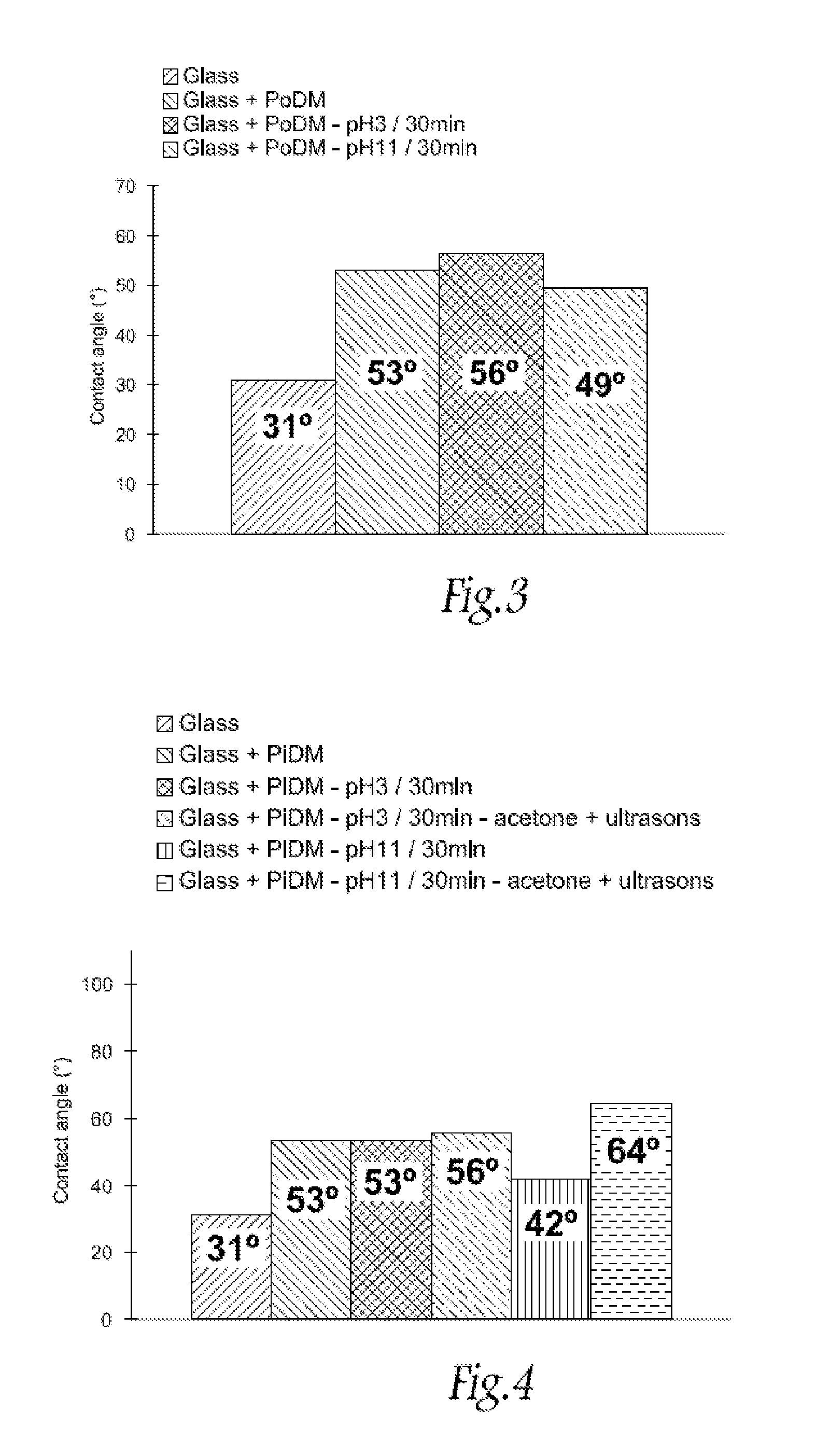Method of coating an inorganic substrate with a stable organic layer
a technology of inorganic substrate and stable organic layer, which is applied in the direction of organic chemistry, coatings, group 5/15 element organic compounds, etc., can solve the problems of limited durability of such layers, inability to maintain interactions, and inability to maintain the stability of the deposited coating
- Summary
- Abstract
- Description
- Claims
- Application Information
AI Technical Summary
Benefits of technology
Problems solved by technology
Method used
Image
Examples
example 1
Preparation of 4-methyl-2,4-pentadiene-2-phosphinic acid (PiDM)
[0112]In a 100 ml flask were added 16.5 g of hypophosphorous acid (H3PO2, 50% in to water), 12.25 g of mesityl oxide (a mixture of 1,2- and 1,3-unsaturated ketone) and 20 ml toluene. The mixture was heated under nitrogen to reflux at 125° C. overnight (around 17 hrs), the water was collected and separated out. 31P NMR showed 86.4% H3PO2 was reacted and 4-methyl-2,4-pentadiene-2-phosphinic acid (PiDM) was obtained at 65.4% is selectivity along with other minor impurities.
example 2
Preparation of 4-methyl-2,4-pentadiene-2-phosphonic acid (PoDM)
[0113]Phosphorous acid, H3PO3 200 g, which was dried for about 4 hrs at 50° C. under vacuum, and 194 g of acetic acid were added to a 2 L flask with cooling. Then 494 g of acetic anhydride was charged and the temperature rose to 25° C. to yield a colorless homogenous mixture. 1 g of phenothiazine was added and the reaction mixture became light orange. Mesityl oxide (a mixture of 1,2 and 1,3 isomers) 284 g was added drop-wise with stirring over about 4 hrs and the temperature was kept at 23-25° C. The color of the reaction mixture became dark orange after the unsaturated ketone addition. The mixture was then heated to 48° C. for 7 hrs. The product, 4-methyl-2,4-pentadiene-2-phosphonic acid (PoDM) and its anhydride derivative were observed in more than 90% selectivity with 100% conversion of phosphorous acid.
example 3
Preparation of Glass Coupons Coated with a Layer Obtained from PiDM or PoDM
[0114]The glass coupons used were first treated sequentially by immersion in a boiling “piranha” solution (3:1, H2O2 30%, H2SO4 98%) for 45 minutes to functionalize glass surface by oxidation, rinsing with distillated water. Si samples thus hydrophilic with this treatment were dried in a stream of N2 and immediately used.
[0115]Then, the glass coupons treated as described above were held vertically in a solution of PiDM or in a solution of PoDM (10−3M in acetone) in a beaker over 3 h. The treated samples were then removed with precaution and heated under vacuum at 150° C. over 20 h to bond the phosphonic acids function to Si02 / Si by dehydration. Any multilayer coated during the process was removed by sonication in acetone over 15 minutes. Samples were then dried in hot oven.
PUM
| Property | Measurement | Unit |
|---|---|---|
| pH | aaaaa | aaaaa |
| pH | aaaaa | aaaaa |
| reaction time | aaaaa | aaaaa |
Abstract
Description
Claims
Application Information
 Login to View More
Login to View More - R&D
- Intellectual Property
- Life Sciences
- Materials
- Tech Scout
- Unparalleled Data Quality
- Higher Quality Content
- 60% Fewer Hallucinations
Browse by: Latest US Patents, China's latest patents, Technical Efficacy Thesaurus, Application Domain, Technology Topic, Popular Technical Reports.
© 2025 PatSnap. All rights reserved.Legal|Privacy policy|Modern Slavery Act Transparency Statement|Sitemap|About US| Contact US: help@patsnap.com



